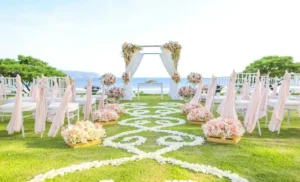Last updated on May 1st, 2025 at 04:47 am
Have you ever wondered what lies behind the subtle embroidery and deep blue of Marian chasubles? Discover with us the richness of symbolism and tradition that has accompanied these unique liturgical vestments for centuries. Learn about the history, the meaning of colors and motifs, and find out how these exceptional works of sacred art are created at HAFTINAUSA. Immerse yourself in a world of beauty and spirituality that emanates from every detail of Marian chasubles.
History and Genesis of Marian Chasubles
The history of Marian chasubles dates back to the beginnings of Christianity, when special reverence began to be given to the Mother of God. Initially, liturgical vestments were simple and modest, but over time, with the development of Marian devotion, they began to be adorned with increasingly sophisticated motifs and symbols.
The Beginnings of Marian Devotion and Its Impact on Liturgical Vestments
Marian devotion, which has been developing since the first centuries of Christianity, has had a tremendous influence on sacred art, including the appearance of liturgical vestments. Mary, as the Mother of God, Queen and advocate of the faithful, occupies a special place in the hearts of Christians. Her images adorn churches, and celebrations in her honor are celebrated with great pomp. This deep piety is also reflected in the appearance of chasubles, which began to be dedicated to Mary.
Development of Marian Ornamentation and Symbolism Over the Centuries
Over the centuries, Marian ornamentation and symbolism on chasubles have changed, reflecting current trends in sacred art and theology. In the Middle Ages, motifs inspired by Byzantine art were popular, such as images of Mary with the Child, surrounded by a mandorla. In the Renaissance, more realistic representations began to be used, and in the Baroque period, rich decorations and gold threads dominated. In the 19th and 20th centuries, there was a return to simpler forms, but still with great attention to symbolism.
Examples of Historical Marian Chasubles and Their Characteristics
In museums and church archives, you can find many examples of historical Marian chasubles that delight with their beauty and craftsmanship. They are often works of art, made of the most expensive materials and decorated with precious stones. They are characterized by rich symbolism, referring to the life and virtues of Mary, and to her role in the history of salvation.
Symbolism of Colors and Motifs on Marian Chasubles
The colors and motifs used on Marian chasubles have deep symbolic meaning, referring to Mary’s virtues, the mysteries of faith, and events from her life.
Blue – Symbol of Heaven, Purity, and Innocence of Mary
The color blue is most often associated with Mary. It symbolizes heaven, purity, innocence, and faithfulness to God. Blue reminds us of Mary’s heavenly origin and her special closeness to God. It is often used in various shades, from light blue, symbolizing hope, to deep navy, signifying majesty and royalty.
Gold and Silver – Reflection of Mary’s Royal Dignity and Her Radiance
Gold and silver are used to emphasize Mary’s royal dignity and her radiance. Gold threads and applications symbolize divinity, glory, and immortality, while silver symbolizes purity, humility, and modesty. The combination of gold and silver on a Marian chasuble expresses the unity of the divine and human element in Mary.
Floral Motifs (Roses, Lilies) – Symbol of Mary’s Virtues and Beauty
Floral motifs, such as roses and lilies, are often used on Marian chasubles as a symbol of Mary’s virtues and beauty. The rose, especially a thornless rose, symbolizes love, beauty, and perfection. The lily, in turn, is a symbol of purity, innocence, and resurrection. Placing these flowers on a Marian chasuble is an expression of homage to the virtues of the Mother of God.
Stars – Symbol of Mary as the Morning Star, Leading to Christ
Stars are another important motif on Marian chasubles. They symbolize Mary as the Morning Star, who leads the faithful to Christ. The star, as a symbol of light and hope, reminds us of Mary’s role as a mediator between God and people. Often, twelve stars are placed on Marian chasubles, referring to the Apocalypse of St. John (Rev 12:1), where Mary is depicted as a Woman clothed with the sun, with a crown of twelve stars on her head.
Marian Letters (e.g., M, AM) – Abbreviations of Mary’s Name and Invocations to Her
On Marian chasubles, letters are often placed that are abbreviations of Mary’s name or invocations to her. The most common are the letters M (Maria) and AM (Ave Maria). These short inscriptions remind us of Mary’s presence and call for prayer to her. Sometimes entire expressions are also placed, such as “Mater Dei” (Mother of God) or “Regina Coeli” (Queen of Heaven).
Craftsmanship and Technology in Creating Marian Chasubles from HAFTINAUSA
HAFTINAUSA combines traditional craftsmanship with modern technology to create Marian chasubles of the highest quality.
Traditional Embroidery and Application Techniques Used in the Production of Chasubles
In our company, we use traditional embroidery and application techniques that are passed down from generation to generation. Our craftsmen, with great precision and attention to every detail, perform hand embroidery and applications that give Marian chasubles a unique character. We use various embroidery techniques, such as flat stitch, cross stitch, richelieu embroidery, and bead embroidery, to achieve a variety of visual effects.
The Use of Computer Embroidery for Precision and Efficiency
In addition to traditional techniques, we also use computer embroidery, which allows for the precise and efficient execution of complex designs and motifs. Computer embroidery is particularly useful for producing chasubles with repetitive patterns or with very fine details. Thanks to the combination of traditional craftsmanship with modern technology, we are able to meet the expectations of even the most demanding customers.
Selection of the Highest Quality Fabrics and Materials
At HAFTINAUSA, we attach great importance to the selection of the highest quality fabrics and materials. We use only natural fabrics, such as silk, linen, and cotton, which are durable, breathable, and pleasant to the touch. To decorate the chasubles, we use high-quality metallic threads, beads, sequins, and precious stones that give them radiance and elegance.
The Design and Production Process of Chasubles – From Inspiration to Realization
The design and production process of Marian chasubles in our company is complex and multi-stage. It begins with inspiration, which we draw from tradition, sacred art, and nature. Then, our designers create sketches and computer designs, which are consulted with customers. After approving the design, we proceed to select fabrics and materials, and then to perform embroidery and applications. At every stage of production, we ensure the highest quality and precision of execution.
Marian Chasuble – An Expression of Faith and Beauty in the Liturgy
A Marian chasuble is not only a liturgical vestment, but above all an expression of faith and love for the Mother of God. Worn during celebrations in honor of Mary, it emphasizes her role in the history of salvation and calls for prayer to her.
Significance of Marian Chasubles in the Liturgy of the Catholic Church
The Marian chasuble occupies a special place in the liturgy of the Catholic Church. It is worn during celebrations in honor of the Blessed Virgin Mary, such as the Solemnity of Mary, Mother of God (January 1), the Solemnity of the Annunciation of the Lord (March 25), the Solemnity of the Assumption of the Blessed Virgin Mary (August 15), and the Solemnity of the Immaculate Conception of the Blessed Virgin Mary (December 8). The color blue, characteristic of Marian chasubles, symbolizes heaven, purity, and Mary’s innocence.
Celebrations and Feasts During Which Marian Chasubles Are Used
Marian chasubles are used during many celebrations and feasts in honor of the Mother of God, such as:
- Solemnity of Mary, Mother of God (January 1)
- Solemnity of the Annunciation of the Lord (March 25)
- Solemnity of the Queen of Poland (May 3)
- Solemnity of the Assumption of the Blessed Virgin Mary (August 15)
- Solemnity of the Immaculate Conception of the Blessed Virgin Mary (December 8)
During these celebrations, priests wear Marian chasubles to emphasize Mary’s role in the history of salvation and to call the faithful to prayer to her.
How to Choose the Right Marian Chasuble – Advice and Tips
Choosing the right Marian chasuble can be difficult, due to the large selection of designs, colors, and materials. When choosing, it is worth considering the following factors:
- Occasion: What occasion do you need the chasuble for? For solemn occasions, it is worth choosing a chasuble with rich decorations and gold threads, and for daily devotions – a simple and modest chasuble.
- Color: What color chasuble is most appropriate? Blue is the traditional color for Marian chasubles, but you can also choose a chasuble in white, gold, or silver.
- Material: What material is best? Silk, linen, and cotton are good choices because they are durable, breathable, and pleasant to the touch.
- Design: What design is most appropriate for the chasuble? It is worth choosing a design that refers to the virtues of Mary and to her role in the history of salvation.
- Price: What is the price of the chasuble? The prices of Marian chasubles range from several hundred to several thousand dollars. It is worth comparing the prices of different chasubles and choosing the one that best suits our needs and financial capabilities.
HAFTINAUSA – Your Partner in Choosing Marian Chasubles
At HAFTINAUSA, we offer a wide selection of Marian chasubles of the highest quality. Our advisors will be happy to help you choose the right chasuble, which will be an expression of your faith and love for the Mother of God. We invite you to familiarize yourself with our offer on the website https://haftinausa.com/









